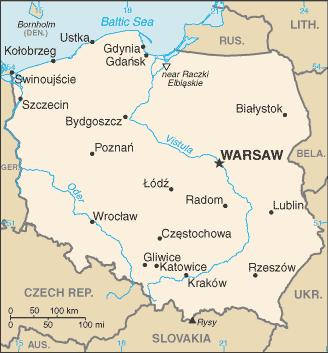

Poland is an ancient nation that was conceived near the
middle of the 10th century. Its golden age occurred in the 16th century. During
the following century, the strengthening of the gentry and internal disorders
weakened the nation. In a series of agreements between 1772 and 1795, Russia,
Prussia, and Austria partitioned Poland amongst themselves. Poland regained
its independence in 1918 only to be overrun by Germany and the Soviet Union
in World War II. It became a Soviet satellite state following the war, but its
government was comparatively tolerant and progressive. Labor turmoil in 1980
led to the formation of the independent trade union "Solidarity" that
over time became a political force and by 1990 had swept parliamentary elections
and the presidency. A "shock therapy" program during the early 1990s
enabled the country to transform its economy into one of the most robust in
Central Europe, but Poland still faces the lingering challenges of high unemployment,
underdeveloped and dilapidated infrastructure, and a poor rural underclass.
Solidarity suffered a major defeat in the 2001 parliamentary elections when
it failed to elect a single deputy to the lower house of Parliament, and the
new leaders of the Solidarity Trade Union subsequently pledged to reduce the
Trade Union's political role. Poland joined NATO in 1999 and the European Union
in 2004. With its transformation to a democratic, market-oriented country largely
completed, Poland is an increasingly active member of European organizations.
Location: northern part of Central Europe, east of Germany
and west of former Soviet Union
Geographic coordinates: 52 00 N, 20 00 E
Area: total: 312,685 sq km (land: 304,465 sq km, water: 8,220 sq km)
Land boundaries: total: 2,788 km (Belarus 407 km, Czech Republic 658 km, Germany
456 km, Lithuania 91 km, Russia (Kaliningrad Oblast) 206 km, Slovakia 444 km,
Ukraine 526 km)
Coastline: 491 km
Maritime claims: territorial sea: 12 nm
exclusive economic zone: defined by international treaties
Climate: temperate with cold, cloudy, moderately severe winters with frequent
precipitation; mild summers with frequent showers and thundershowers
Terrain: mostly flat plain; mountains along southern border
Elevation extremes: lowest point: near Raczki Elblaskie -2 m, highest point:
Rysy 2,499 m
Population: 38,635,144 (July 2005 est.)
Median age: total: 36.43 years
Ethnic groups: Polish 96.7%, German 0.4%, Belarusian 0.1%, Ukrainian 0.1%, other
2.7%
Religions: Roman Catholic 89.8% (about 75% practicing), Eastern Orthodox 1.3%,
Protestant 0.3%, other 0.3%, unspecified 8.3%
Languages: Polish (official)
Literacy: 99.8%
Country name: Republic of Poland (conventional short form:
Poland)
Government type: parliamentary republic
Capital: Warsaw
Administrative divisions: 16 provinces (wojewodztwa, singular - wojewodztwo);
Dolnoslaskie, Kujawsko-Pomorskie, Lodzkie, Lubelskie, Lubuskie, Malopolskie,
Mazowieckie, Opolskie, Podkarpackie, Podlaskie, Pomorskie, Slaskie, Swietokrzyskie,
Warminsko-Mazurskie, Wielkopolskie, Zachodniopomorskie
Independence: 11 November 1918 (independent republic proclaimed)
National holiday: Constitution Day, 3 May - In 1791 the Europe first Constitution
was adopted.
Suffrage: 18 years of age; universal
Poland has steadfastly pursued a policy of economic liberalization
throughout the 1990s and today stands out as a success story among transition
economies. Even so, much remains to be done, especially in bringing down the
unemployment rate-currently the highest in the EU. The privatization of small
and medium-sized state-owned companies and a liberal law on establishing new
firms has encouraged the development of the private business sector, but legal
and bureaucratic obstacles alongside persistent corruption are hampering its
further development. Poland's agricultural sector remains handicapped by surplus
labor, inefficient small farms, and lack of investment. Restructuring and privatization
of "sensitive sectors" (e.g., coal, steel, railroads, and energy),
while recently initiated, have stalled. Reforms in health care, education, the
pension system, and state administration have resulted in larger-than-expected
fiscal pressures. Further progress in public finance depends mainly on reducing
losses in Polish state enterprises, restraining entitlements, and overhauling
the tax code to incorporate the growing gray economy and farmers, most of whom
pay no tax. The previous Socialist-led government introduced a package of social
and administrative spending cuts to reduce public spending by about $17 billion
through 2007, but full implementation of the plan was trumped by election-year
politics in 2005. The right-wing Law and Justice party won parliamentary elections
in September, and Lech Kaczynski won the presidential election in October, running
on a state-interventionist fiscal and monetary platform. Poland joined the EU
in May 2004, and surging exports to the EU contributed to Poland's strong growth
in 2004, though its competitiveness could be threatened by the zloty's appreciation.
GDP per capita roughly equals that of the three Baltic states. Poland stands
to benefit from nearly $23.2 billion in EU funds, available through 2006. Farmers
have already begun to reap the rewards of membership via booming exports, higher
food prices, and EU agricultural subsidies.
GDP - per capita: $12,700 (2005 est.)
Unemployment rate: 18.3% (2005)
Exports - partners: Germany 30%, Italy 6.1%, France 6%, UK 5.4%, Czech Republic
4.3%, Netherlands 4.3% (2004)
Imports - partners: Germany 24.4%, Italy 7.9%, Russia 7.3%, France 6.7%, China
4.6% (2004)
Currency: zloty (PLN)
Internet country code: .pl